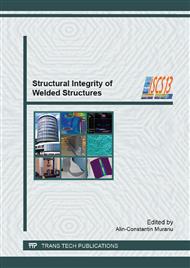[1]
N. A. Makarenko, V. A. Nevidomskij, Thermal cycles in plasma-MIG surfacing [J]. Automatic Welding, 1, (2003) 145−47.
Google Scholar
[2]
E. Taban, J. E. Gould, J.C. Lippold, Dissimilar friction welding of 6061-T6 aluminum and AISI 1018 steel: Properties and microstructural characterization, Mater. and Design, 31 (2010) 2305–2311.
DOI: 10.1016/j.matdes.2009.12.010
Google Scholar
[3]
M. A. Oliveira, J. C. Dutra Electrical mode for the plasma-MIG hybrid welding process [J]. Welding and Cutting, 6 (2007) 324−328.
Google Scholar
[4]
H. Uzun, C.D. Donne, A. Argagnotto, T. Ghidini, C. Gambaro, Friction stir welding of dissimilar Al 6013-T4 To X5CrNi18-10 stainless steel, Mater Design., 26 (2005) 41–46.
DOI: 10.1016/j.matdes.2004.04.002
Google Scholar
[5]
L. Bill, Activating flux – improving the performance of the TIG process, Welding 68 (2000) 7-10.
Google Scholar
[6]
D. Dană, P. Vizureanu, R. Cimpoeșu, Basic Braze-Welding Operation Characterististics, Metalurgia International, XVII (6) (2012) 40-43.
Google Scholar
[7]
A Joseph, C. Webb, M. Haramia, D. Yapp, Variable Polarity Improves Weld Brazing of Galvanized Sheet, Welding Journal, 10 (2001) 36-39.
Google Scholar
[8]
Chesmond, C.J., Base Control System Technology. Ed. Arnold, London, 2001.
Google Scholar
[9]
N. Cimpoeşu, S. Stanciu, M. Meyer, I. Ioniţă, R. Cimpoeşu Hanu, Effect of stress on damping capacity of a shape memory alloy CuZnAl, J. of Optoelectronics and Advanced Mater., 12 (2), (2010) 386-391.
Google Scholar
[10]
E. Ranjbarnodeh, S. Weiss, S. Hanke, A. Fischer, EBSD characterization of the effect of welding parameters on HAZ of AISI409, Min. Metall. Sect. B-Metall. 48 (1) B (2012) 115-121.
DOI: 10.2298/jmmb110718015r
Google Scholar
[11]
B. Godec, V. Grdun, Braze welding of galvanised steel pipes, Welding in the World, 57 (3) (2002).
Google Scholar
[12]
Y.-S. Liao, C.-C. A. Chen, C.-L. Chao, P.-L. Tso, Effect of Wheel Arrangement on Ground Surface Topography in Horizontal-Axis-Type Rotary Surface Grinding, Advanced Materials Research, 126 – 128 (2010) 579-584.
DOI: 10.4028/www.scientific.net/amr.126-128.579
Google Scholar
[13]
M.-A. Paun, R. Cimpoesu Hanu, N. Cimpoesu, M. Agop, C. Baciu, S. Stratulat, C. Nejneru, Internal friction phenomena at polymeric and metallic shape memory materials. Experimental and theoretical results, Materiale Plastice, 47 (2010) 209-214.
Google Scholar
[14]
R. Prokic-Cvetkovic , S. Kastelec-Macura, A. Milosavljevic, O. Popovic, M. Burzic, The effect of shielding gas composition on the toughness and crack growth parameters of AlMg4,5Mn weld metals, J. Min. Metall. Sect. B-Metall. 46 (2) B (2010) 193-202.
DOI: 10.2298/jmmb1002193p
Google Scholar
[15]
Q. Yang, X. Du, X. Zhang, X. Wang, F. He, The Conceptual Design of Exercise Washing Machine Based on Trimming, Applied Mechanics and Materials, 215 – 216 (2010) 561-565.
DOI: 10.4028/www.scientific.net/amm.215-216.561
Google Scholar
[16]
Y. M. Gao, Y. Jiang, S. Huang, Reduction of molybdenum oxide from steelmaking slags by pure liquid iron, J. Min. Metall. Sect. B-Metall. 48 (1) B (2012) 25-36.
DOI: 10.2298/jmmb110620006g
Google Scholar


